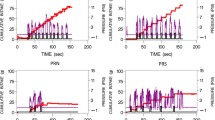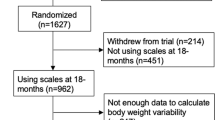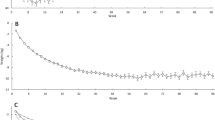Abstract
Background:
The Tissue Monitoring System (TMS) is an algorithm that estimates changes in body tissue from a series of daily weight measures. It is intended to provide people with a feedback of changes in their tissue weight so they may have a basis for estimating how much they would have to change their intake or expenditure to maintain their weight at a prescribed level. We tested the effectiveness of the TMS to prevent freshmen from gaining weight during their first semester in college.
Methods:
In two similar but independent studies (Fall 2002, 2003), female freshmen college students were given analog bathroom scales and instructed to weigh themselves each morning immediately after rising from bed, then e-mail their weight to our staff. After 7 days, a linear function was performed on the most recent 7 days of the weight-day function for each participant. In the first study, the slope of this function was e-mailed back to the participants. In the second study, the difference between last point and the original weight was determined, using linear regression techniques, converted to calories, and the information was e-mailed back to the participants. Control participants in both studies were weighed at the beginning and the end of the semester.
Results:
The untreated controls gained 3.1±0.51 kg and 2.0±0.65 kg, respectively (P<0.01 for both studies), whereas weight gain of the experimental groups was 0.1±0.99 kg and −0.82±0.56 kg, values that were not significantly different than zero.
Conclusions:
The TMS appears to be an effective technique to help female college freshmen resist gaining weight in an environment that is conducive to weight gain. These results suggest that the TMS may be a useful method to help curb the slow increase in the prevalence of overweight and obesity that is characteristic of all industrialized societies.
This is a preview of subscription content, access via your institution
Access options
Subscribe to this journal
Receive 12 print issues and online access
$259.00 per year
only $21.58 per issue
Buy this article
- Purchase on Springer Link
- Instant access to full article PDF
Prices may be subject to local taxes which are calculated during checkout






Similar content being viewed by others
References
Heckerman CL, Brownell KD, Westlake RJ . Self and external monitoring of weight. Psychol Rep 1978; 43 (2): 375–378.
Buckmaster L, Brownell K . Behavioral modification: the state of the art. In: Frankle R, Rockville YM (eds) Obesity and Weight Control 1988. Aspen Publishers: Rockville, MD.
Cooper Z, Fairburn C . Cognitive-behavioral treatment of obesity. In: Wadden T, Stunkard A (eds) Handbook of Obesity Treatment 2002. The Gulford Press: New York.
Perri A, Nezu A, Viegener B . Improving the Long-Term Management of Obesity: Theory, Research, and Clinical Guidelines. Wiley: New York, 1992.
Wadden T . The treatment of obesity: an overview. In: Stunkard A, Wadden T (eds). Obesity: Theory and Therapy. Raven Press: New York, 1993. pp 197–218.
Klem ML, Wing RR, McGuire MT, Seagle HM, Hill JO . A descriptive study of individuals successful at long-term maintenance of substantial weight loss. Am J Clin Nutr 1997; 66 (2): 239–246.
Fujimoto K, Sakata T, Etou H, Fukagawa K, Ookuma K, Terada K et al Charting of daily weight pattern reinforces maintenance of weight-reduction in moderately obese patients. Amer J Med Sci, 1992; 303 (3): 145–150.
Basiotis PP, Thomas RG, Kelsay JL, Mertz W . Sources of variation in energy intake by men and women as determined from one year's daily dietary records. Am J Clin Nutr 1989; 50 (3): 448–453.
de Castro JM . Weekly rhythms of spontaneous nutrient intake and meal pattern of humans. Physiol Behav 1991; 50 (4): 729–738.
Beaton GH, Milner J, McGuire V, Feather TE, Little JA . Source of variance in 24-h dietary recall data: implications for nutrition study design and interpretation. Carbohydrate sources, vitamins, and minerals. Am J Clin Nutr 1983; 37 (6): 986–995.
Bhargava A, Forthofer R, McPherson S, Nichaman M . Estimating the variations and autocorrelations in dietary intakes on weekdays and weekends. Stat Med 1994; 13 (2): 113–126.
Levitsky DA, Halbmaier CA, Mrdjenovic G . The freshman weight gain: a model for the study of the epidemic of obesity. Int J Obes Relat Metab Disord 2004; 28 (11): 1435–1442.
Anderson DA, Shapiro JR, Lundgren JD . The freshman year of college as a critical period for weight gain: an initial evaluation. Eat Behav 2003; 4 (4): 363–367.
Hovell MF, Mewborn CR, Randle Y, Fowler-Johnson S . Risk of excess weight gain in university women: a three-year community controlled analysis. Addict Behav 1985; 10 (1): 15–28.
Butler SM, Black DR, Blue CL, Gretebeck RJ . Change in diet, physical activity, and body weight in female college freshman. Am J Health Behav 2004; 28 (1): 24–32.
Matvienko O, Lewis DS, Schafer E . A college nutrition science course as an intervention to prevent weight gain in female college freshmen. J Nutr Educ Behav 2001; 33 (2): 95–100.
Hall SM, Bass A, Monroe J . Continued contact and monitoring as follow-up strategies: a long-term study of obesity treatment. Addict Behav 1978; 3 (2): 139–147.
Baum JG, Clark HB, Sandler J . Preventing relapse in obesity through posttreatment maintenance systems: comparing the relative efficacy of two levels of therapist support. J Behav Med 1991; 14 (3): 287–302.
Perri MG, McAdoo WG, Spevak PA, Newlin DB . Effect of a multicomponent maintenance program on long-term weight loss. J Consult Clin Psychol 1984; 52 (3): 480–481.
Perri MG, McAllister DA, Gange JJ, Jordan RC, McAdoo G, Nezu AM . Effects of four maintenance programs on the long-term management of obesity. J Consult Clin Psychol 1988; 56 (4): 529–534.
Harvey-Berino J, Pintauro S, Buzzell P, DiGiulio M, Casey Gold B, Moldovan C et al Does using the Internet facilitate the maintenance of weight loss? Int J Obes Relat Metab Disord 2002; 26 (9): 1254–1260.
Harvey-Berino J, Pintauro SJ, Gold EC . The feasibility of using Internet support for the maintenance of weight loss. Behav Modif 2002; 26 (1): 103–116.
National Task Force on the Prevention and Treatment of Obesity. Dieting and the development of eating disorders in overweight and obese adults. Arch Intern Med 2000; 160 (17): 2581–2589.
Katzmarzyk PT . The Canadian obesity epidemic: an historical perspective. Obes Res 2002; 10 (7): 666–674.
Korman L . The growing epidemic of obesity. N J Med Assoc 2002; 99 (7–8): 30–39.
Mokdad AH, Serdula MK, Dietz WH, Bowman BA, Marks JS, Koplan JP . The spread of the obesity epidemic in the United States, 1991–1998. JAMA 1999; 282 (16): 1519–1522.
Mokdad AH, Serdula MK, Dietz WH, Bowman BA, Marks JS, Koplan JP . The continuing epidemic of obesity in the United States. JAMA 2000; 284 (13): 1650–1651.
Gross LS, Li L, Ford ES, Liu S . Increased consumption of refined carbohydrates and the epidemic of type 2 diabetes in the United States: an ecologic assessment. Am J Clin Nutr 2004; 79 (5): 774–779.
Schmitz KH, Jacobs Jr DR, Leon AS, Schreiner PJ, Sternfeld B . Physical activity and body weight: associations over ten years in the CARDIA study. Coronary Artery Risk Development in Young Adults. Int J Obes Relat Metab Disord 2000; 24 (11): 1475–1487.
Bray GA, Nielsen SJ, Popkin BM . Consumption of high-fructose corn syrup in beverages may play a role in the epidemic of obesity. Am J Clin Nutr 2004; 79 (4): 537–543.
Young LR, Nestle M . The contribution of expanding portion sizes to the US obesity epidemic. Am J Public Health 2002; 92 (2): 246–249.
Ebbeling CB, Sinclair KB, Pereira MA, Garcia-Lago E, Feldman HA, Ludwig DS . Compensation for energy intake from fast food among overweight and lean adolescents. JAMA 2004; 291 (23): 2828–2833.
Jeffery RW, French SA . Epidemic obesity in the United States: are fast foods and television viewing contributing? Am J Public Health 1998; 88 (2): 277–280.
Putnam J, Allshouse J . Food Consumption, Prices, and Expenditures, 1997–97. Statistical Bulletin No. 965. Vol. 965, E.R. Service. United States Department of Agriculture: Washington, DC, 1999. pp 1–196.
USDA. Agricultural Statistics 2004. United States Government Printing Office: Washington, DC, 2004.
Flegal KM, Carroll MD, Ogden CL, Johnson CL . Prevalence and trends in obesity among US adults, 1999–2000. JAMA 2002; 288 (14): 1723–1727.
Author information
Authors and Affiliations
Corresponding author
Rights and permissions
About this article
Cite this article
Levitsky, D., Garay, J., Nausbaum, M. et al. Monitoring weight daily blocks the freshman weight gain: a model for combating the epidemic of obesity. Int J Obes 30, 1003–1010 (2006). https://doi.org/10.1038/sj.ijo.0803221
Received:
Revised:
Accepted:
Published:
Issue Date:
DOI: https://doi.org/10.1038/sj.ijo.0803221
Keywords
This article is cited by
-
Effect of the weight-loss program using daily self-weighing combined with personalized counseling led by village health volunteers in adults with obesity in a rural community, Thailand: a randomized controlled trial
BMC Primary Care (2023)
-
The Balance protocol: a pragmatic weight gain prevention randomized controlled trial for medically vulnerable patients within primary care
BMC Public Health (2019)
-
The Association among Emotions and Food Choices in First-Year College Students Using mobile-Ecological Momentary Assessments
BMC Public Health (2018)
-
Daily self-weighing and weight gain prevention: a longitudinal study of college-aged women
Journal of Behavioral Medicine (2017)
-
Freshman 15 in England: a longitudinal evaluation of first year university student’s weight change
BMC Obesity (2016)



